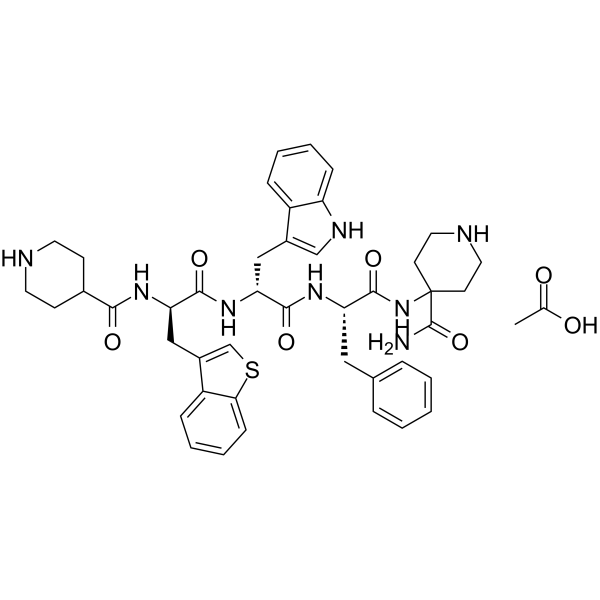1809080-14-5
| Name | Relamorelin acetate |
|---|
| Description | Relamorelin (RM-131) acetate, a Ghrelin analog, is a potent ghrelin receptor agonist, with a Ki of 0.42 nM for GHS-1a. Relamorelin acetate can promote food intake and adiposity in mice. Relamorelin acetate can be used for the research of cachexia, gastroparesis, and gastric/intestinal dysmobility disorders[1][2][3]. |
|---|---|
| Related Catalog | |
| Target |
Ki: 0.42 nM (GHS-1a)[1] |
| In Vitro | Relamorelin shows ∼3 times greater affinity for GHS-1a (Ki=0.42 nM) than native ghrelin (Ki=1. 12 nM)[1]. Relamorelin is 6 times more potent (EC50=0.71 nM) in activating the GHS-1a receptor than native ghrelin (EC50=4.2 nM) as assessed in vitro by calcium mobilization[1]. |
| In Vivo | Relamorelin (500 nmol/kg/day; continuous infusion for 5 days) increases the food intake and weight gain in rats[1]. Relamorelin (50-500 nmol/kg/day; continuous infusion for 5 days) decreases the loss of body mass and fat mass[1]. RM-131 (250-500 nmol/kg; a single s.c.) stimulates acute food intake in wt but not growth hormone secretagogue receptor (GHR) ko mice[2]. Animal Model: F344/NTacfBR male rats implanted with tumor[1] Dosage: 50, 500 nmol/kg/day Administration: Continuous infusion at a rate of 0.5 μL/h for 5 d s.c. Result: Resulted in an increase in food intake (tumor/saline 41.4 g, tumor/BIM-28131 72.5 g) and weight gain (tumor/saline -10.3%, tumor/BIM-28131 +19.5%). |
| References |
| Molecular Formula | C45H54N8O7S |
|---|---|
| Molecular Weight | 851.02 |
